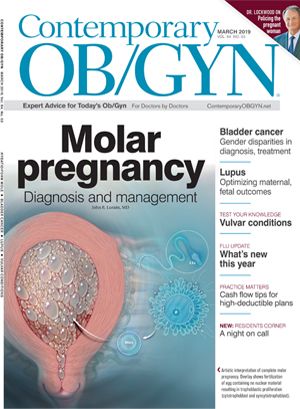Hydatidiform mole: Recognition and management
Molar pregnancies may be associated with serious morbidity so prompt diagnosis, appropriate management, and follow-up are essential.
Illustration by Alexandra Webber Baker, DNA Illustrations Inc. Click here to see more of her work.
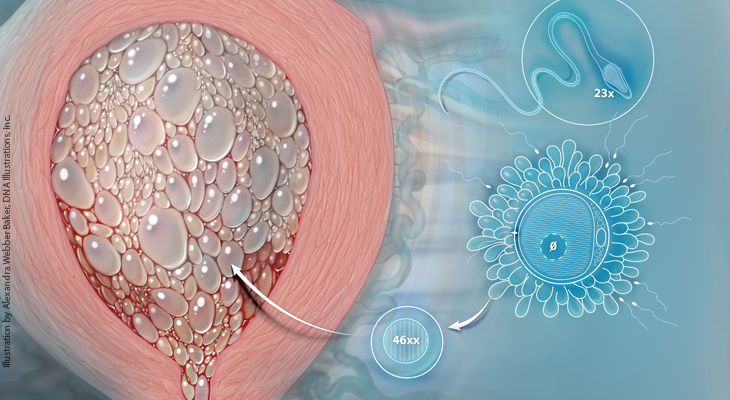
Table 1
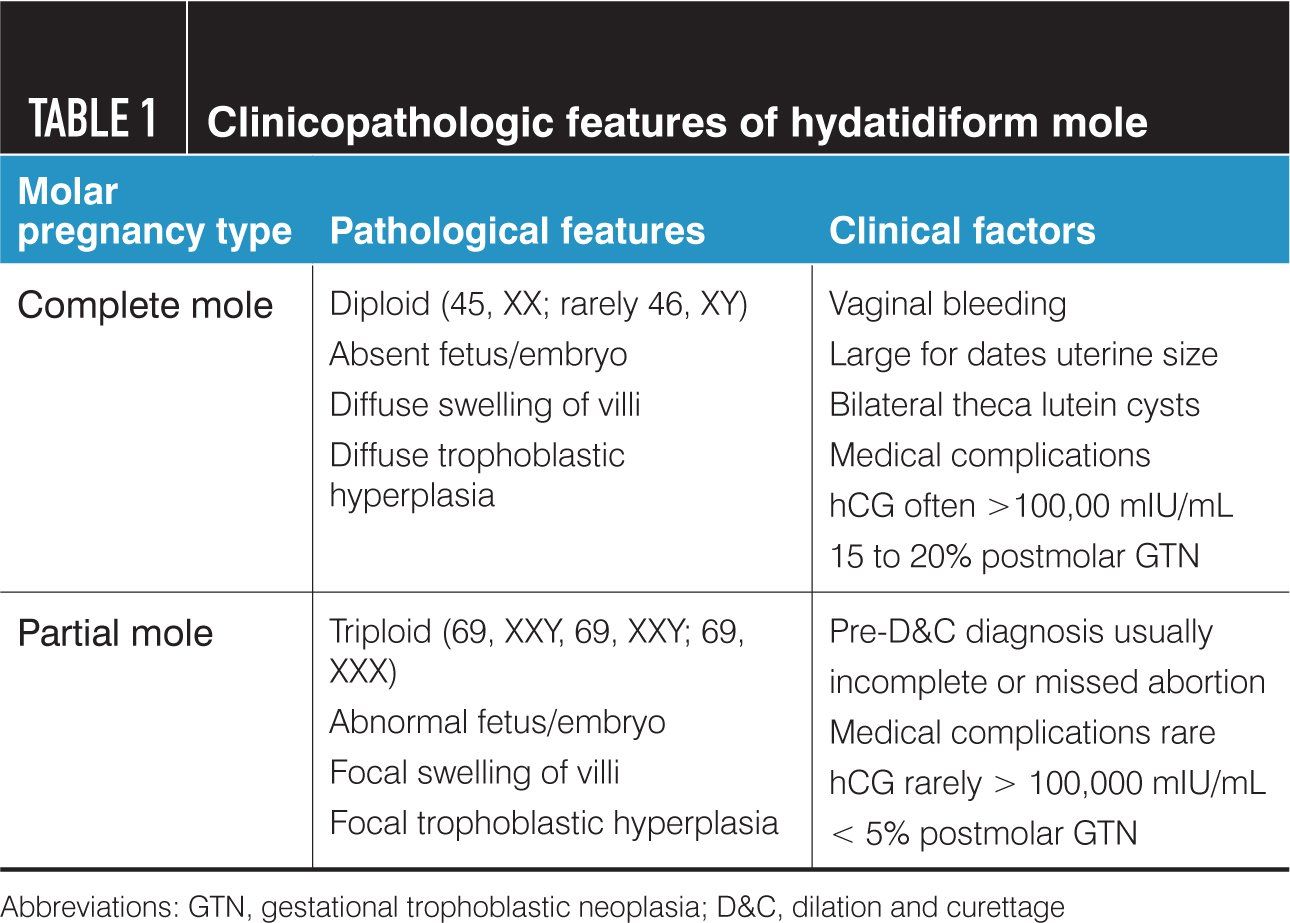
Table 2
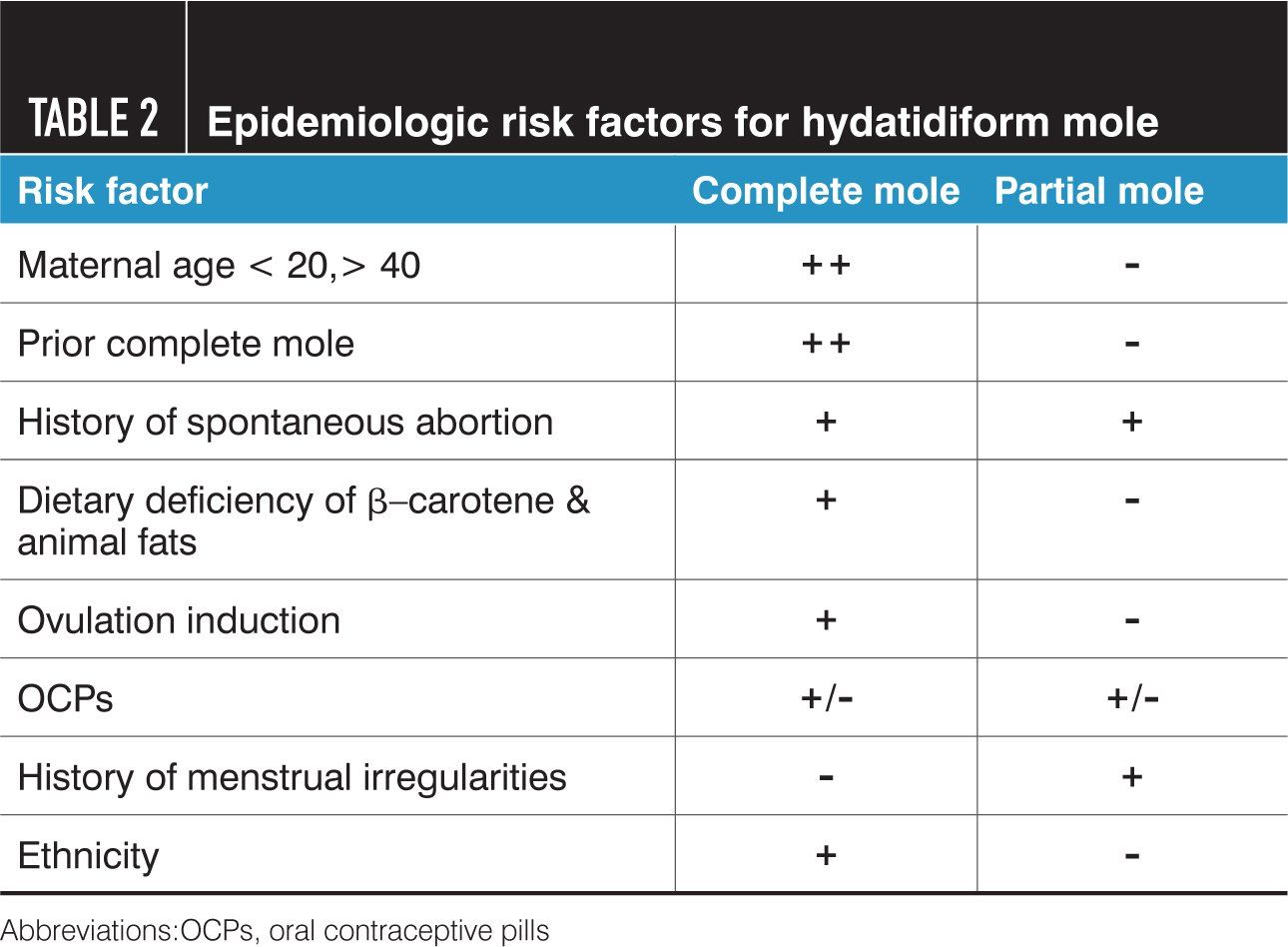
Figure 1
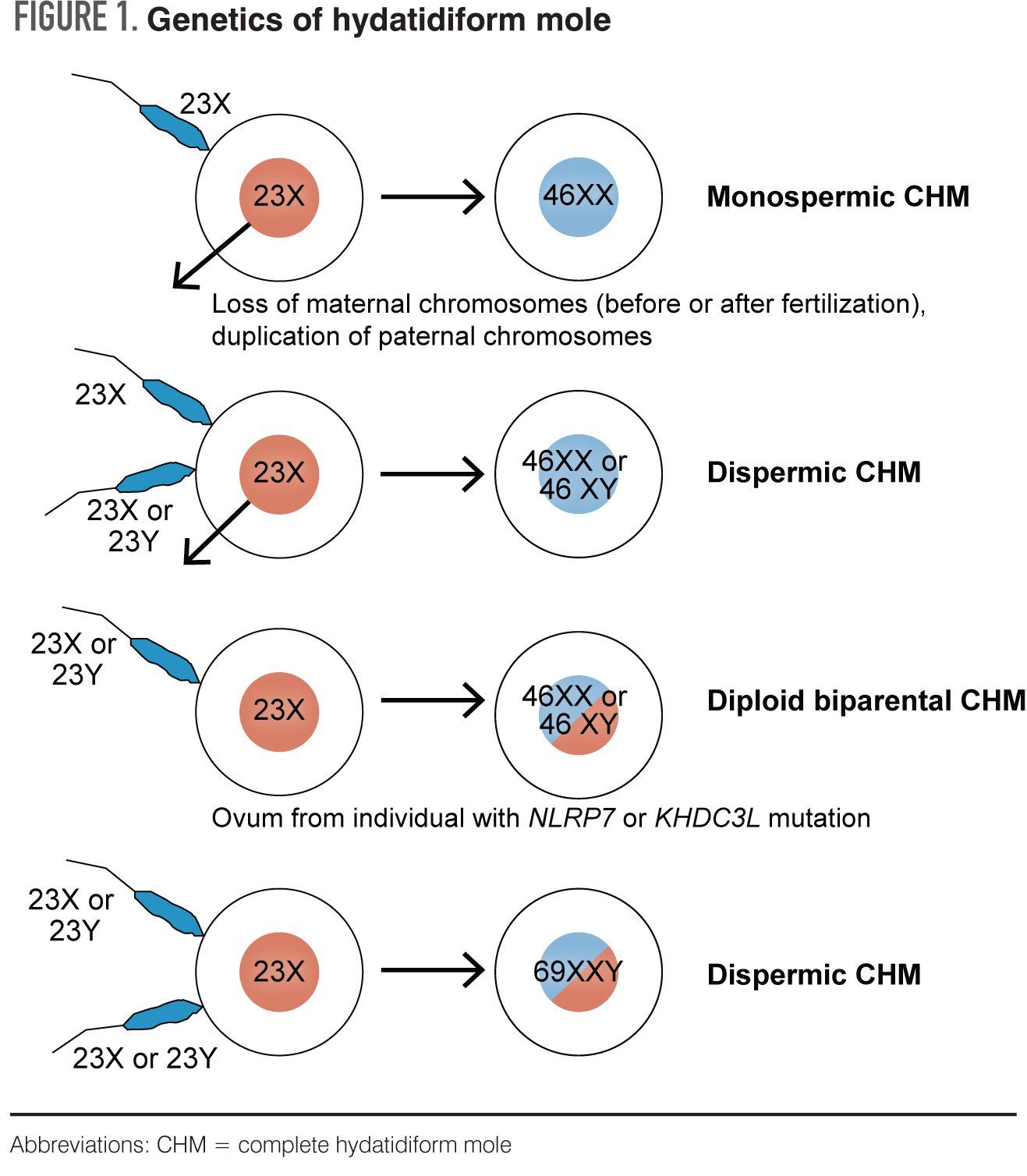
Figure 2
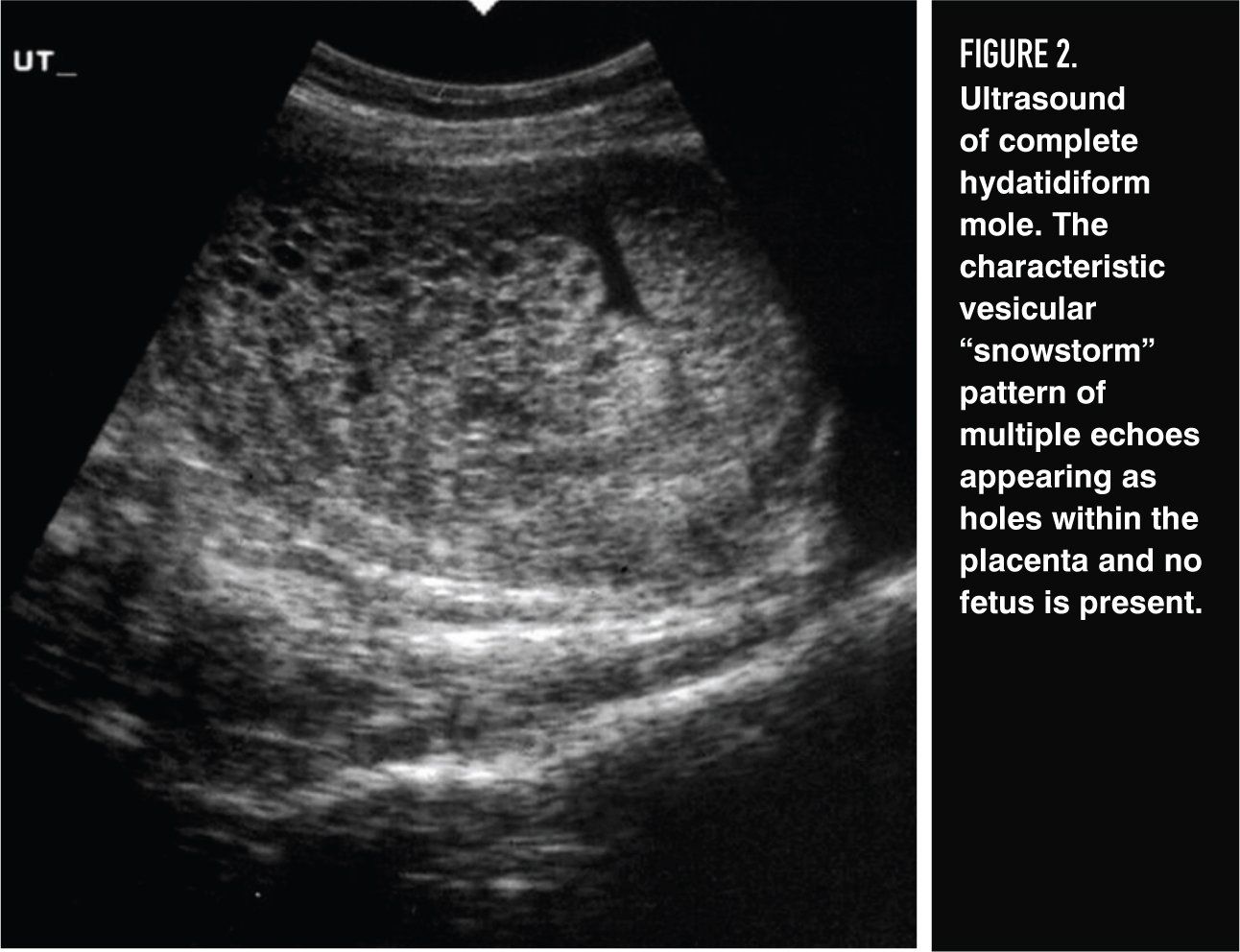
Figures 3A, 3B, 3C
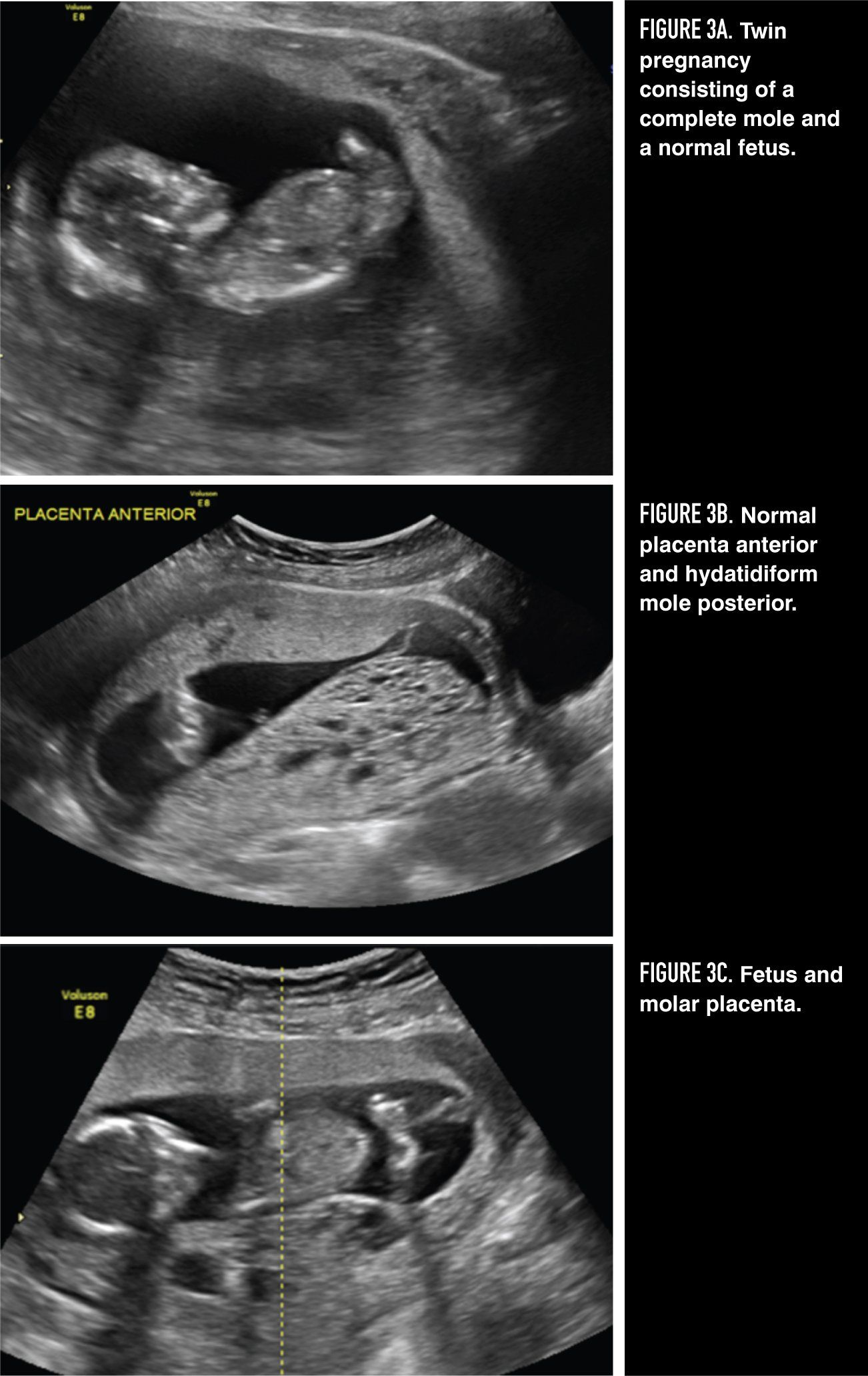
Hydatidiform mole is an abnormal pregnancy characterized by varying degrees of trophoblastic proliferation (both cytotrophoblast and syncytiotrophoblast) and vesicular swelling of placental villi associated with an absent or abnormal fetus/embryo. Two types of hydatidiform mole, complete and partial, have been described based on both morphologic and cytogenetic criteria (Table 1). 1,2
Epidemiology
Epidemiologic studies have reported wide regional variations in the incidence of molar pregnancies. Estimates from studies in North America, Europe, Australia and New Zealand have shown incidence rates ranging from 0.57-1.1 per 1000 pregnancies, whereas studies in Southeast Asia and Japan have suggested an incidence rate as high as 2.0 per 1000 pregnancies. These reported differences may be related to lack of standardization of data collection and reporting rather than true incidence differences. However, socioeconomic status and diet rather than genetic or cultural factors may also contribute to these reported differences in incidence rates. Declining incidence of molar pregnancies in Asia has been attributed to increasing western diet and improved standard of living. The overall incidence of molar pregnancies in the United States and Europe is about 1/1000 pregnancies for both complete and partial moles.1,2
Several potential etiologic risk factors for development of molar pregnancy have been evaluated (Table 2).3 For complete hydatidiform moles, two well-established risk factors have emerged: (1) extremes of maternal age; and (2) prior molar pregnancy. Both advanced and very young maternal age have consistently correlated with higher rates of complete mole. Compared to risk in women aged 21 to 35 years, risk of complete mole is 1.9 times higher for women both < 21 years and > 35 years and 7.5 times higher for women > 40 years, including 1 in 3 pregnancies for women > 50 years. These observations suggest that ova of very young or older women are predisposed to abnormal fertilization events that lead to complete hydatidiform moles. Prior complete molar pregnancy increases risk of developing a subsequent complete molar pregnancy.
Risk of a repeat molar pregnancy after one mole is approximately 1%, about 10 to 20 times the risk for the general population, while after two moles, the risk of a third mole is 15% to 20%. History of prior spontaneous abortion also appears to increase risk of a molar pregnancy (both complete and partial) 2- to 3-fold compared to women without a history of prior miscarriage. Dietary deficiency of β-carotene and animal fat has been linked to an increase in complete moles. There appears to be a possible increased risk of molar pregnancy (partial and complete) with a history of oral contraceptive use, while ovulation induction regimens may be associated with an increase in twin pregnancies consisting of a normal fetus(es) and a complete mole.
While several definite etiologic risk factors have been identified for complete moles, the epidemiologic characteristics of partial moles differ and are less well defined. Importantly, the association between maternal age and complete molar pregnancies is not seen in women with partial molar pregnancies. Furthermore, partial molar pregnancies are more common in women with a history of irregular menses, miscarriage, and oral contraceptive use for > 4 years, but are not associated with ethnicity, ovulation induction, or dietary factors.
Genetics
Complete hydatidiform moles usually arise when an ovum without maternal chromosomes is fertilized by one sperm which then duplicates its DNA, resulting in a 46, XX androgenic karyotype in which all the chromosomes are paternally derived. About 10% of complete moles are 46, XY or 46, XX arising from fertilization of an “empty ovum” by two sperm. Bipaternal diploid complete moles are associated with a maternal autosomal-recessive missense gene mutation, most commonly NLRP7 on chromosome 19q, which results in repetitive molar pregnancies. Partial hydatidiform moles have a triploid karyotype, usually 69, XXY, resulting from dispermic fertilization of an apparently normal ovum (Figure 1).2
Pathology
Complete hydatidiform moles undergo early and uniform hydatid enlargement of villi in the absence of an ascertainable fetus or embryo, the trophoblast is consistently hyperplastic with varying degrees of atypia, and villous capillaries are absent. Partial hydatidiform moles demonstrate identifiable fetal or embryonic tissue, chorionic villi of varying size and shape with focal edema, scalloping and prominent stromal inclusions, a functioning villous circulation, as well as focal trophoblastic hyperplasia with only mild atypia. Immunohistochemical staining for p57 (a parentally imprinted, maternally expressed gene) may be useful for differentiating a positive partial mole from a negative complete mole, but cannot be used to distinguish a partial mole from a nonmolar abortus both of which are positive.4-6
Clinical presentation
Complete hydatidiform moles most commonly present with vaginal bleeding, usually occurring at 6 to 16 weeks of gestation in 90% of cases. The other classical clinical signs and symptoms, such as uterine enlargement greater than expected for gestational dates (28%), hyperemesis (8%), and toxemia, hyperthyroidism, and trophoblastic embolization (< 1%), occur less frequently in more recent years due to earlier diagnosis as a result of widespread use of ultrasonography and accurate tests for human chorionic gonadotrophin (hCG). Bilateral theca lutein cyst enlargement of the ovaries occurs in approximately 15% of cases, hCG levels are often > 100,000 mIU/mL, and fetal heart sounds are absent.7,8
Partial hydatidiform moles do not have the same presenting features as complete moles. Although the main presenting symptom is also vaginal bleeding, which occurs in about 75% of patients, excessive uterine enlargement, hyperemesis, pregnancy-induced hypertension, hyperthyroidism, and theca lutein cysts develop infrequently. Fewer than 10% have hCG levels > 100,000 mIU/mL. More than 90% of patients with partial moles have symptoms and ultrasound findings consistent with an incomplete or missed abortion, and the diagnosis is usually made only after histologic examination of uterine curettage specimens.9
Diagnosis
Ultrasonography plays a critical role in the diagnosis of both complete and partial molar pregnancy, and it has virtually replaced all other means of preoperative diagnosis. Because the chorionic villi of complete moles exhibit diffuse hydropic swelling, a characteristic vesicular ultrasonographic pattern can be observed consisting of multiple echoes (holes) within the placental mass and usually no fetus (Figure 2). Ultrasonography may also facilitate early diagnosis of a partial mole by demonstrating focal cystic spaces within the placenta and an increase in the transverse diameter of the gestational sac.12
hCG is a disease-specific tumor marker produced by the trophoblast of hydatidiform moles and gestational trophoblastic neoplasms as well as normal pregnancy. Hydatidiform moles are commonly associated with markedly elevated hCG levels above those of normal pregnancy. Approximately 50% of complete moles have pre-evacuation hCG levels > 100,000 mIU/mL. However, a single hCG level is seldom helpful in differentiating a compete mole from another type of pregnancy. Partial moles, on the other hand, are most often not associated with such elevated hCG levels, as noted previously.13
Despite earlier diagnosis of complete moles resulting in fewer complications, there has not been a simultaneous reduction in incidence of postmolar gestational trophoblastic neoplasia (GTN).
Management
Once the diagnosis of molar pregnancy is suspected based on history, physical examination, hCG level, and ultrasound findings, the patient should be evaluated for the presence of medical complications (anemia, preeclampsia, hyperthyroidism), which may need to be corrected. Basic laboratory tests should include complete blood count, comprehensive metabolic panel, thyroid function test, urinalysis, and chest x-ray, as well as blood type and screen with cross match if anemic or uterus
≥ 16-week gestational size. An electrocardiogram and coagulation profile may also be indicated. Once the patient is determined to be hemodynamically stable, the most appropriate method of molar evacuation should be decided upon.1, 2,14
Suction evacuation and curettage is the preferred method of evacuation of a hydatidiform mole, independent of uterine size, for patients who wish to maintain their fertility. After anesthesia is achieved, the cervix is dilated to allow a 12- to 14-mm suction cannula to pass into the lower uterine segment and then rotated as the intrauterine contents are removed, preferably under ultrasound guidance. Suction evacuation should be followed by gentle sharp curettage. Uterotonic drugs should be started after initiation of evacuation of the uterus, although oxytocin receptors may be absent. Because risk of excessive bleeding increases with uterine size, 2 units of blood should be immediately available when the uterus is
≥ 16-week gestational size. Attention to blood and crystalloid replacement decreases pulmonary complications. It is clear that with judicious use of appropriate equipment, access to blood products, careful intraoperative monitoring, and early anticipation of complications, patient outcomes improve. Patients who are Rh-negative should receive Rho(D) immune globulin at the time of evacuation, as Rh D factor is expressed on trophoblastic cells.
Hysterectomy is an alternative to suction curettage in patients who do not wish to preserve fertility or are older and at increased risk for development of postmolar GTN. The adnexa may be left intact even in the presence of theca lutein cysts. In addition to evacuating the molar pregnancy, hysterectomy provides permanent sterilization and eliminates risk of local myometrial invasion as a cause of persistent disease. Because of the potential for metastatic disease even after hysterectomy, risk of postmolar GTN still remains at 3% to 5%, thereby requiring continued hCG follow up.
Medical induction of labor and hysterotomy are not recommended for molar evacuation. These methods increase maternal morbidity, such as blood loss, incomplete evacuation requiring curettage, and the requirement for cesarean delivery in subsequent pregnancies. They also increase trophoblastic dissemination and the development of postmolar GTN requiring chemotherapy.
Prophylactic chemotherapy at the time or immediately after evacuation of a molar pregnancy is associated with a reduction in incidence of postmolar GTN from approximately 15% to 20% down to 3% to 8%.15 Use of prophylactic chemotherapy should be limited, however, to special situations in which risk of postmolar GTN is much greater than normal (age > 40 years, hCG > 100,000 mIU/mL, excessive uterine enlargement, theca lutein cysts > 6 cm, medical complications) and/or when adequate hCG follow-up is unavailable or unreliable. Essentially all patients who are followed with serial hCG testing after molar evacuation and are found to have persistent GTN can be cured with appropriate chemotherapy.
Twin pregnancy consisting of a complete mole and a coexisting normal fetus is estimated to occur once in every 22,000 to 100,000 pregnancies (Figure 3). It must be distinguished from a partial mole (triploid pregnancy with fetus). The diagnosis can usually be established by ultrasound, but cytogenetics may be used to differentiate between chromosomally normal, potentially viable fetuses and triploid nonviable fetuses. Patients with a normal fetus/complete mole twin pregnancy should be cautioned that they may be at increased risk for hemorrhage, medical complications, and development of persistent GTN. Suction evacuation and curettage in the operating room under ultrasound guidance is recommended for desired pregnancy termination, bleeding, or medical complications. However, up to 40% of these pregnancies will result in normal viable births if allowed to continue.16,17
Follow-up
After evacuation of a hydatidiform mole, follow-up is essential to detect trophoblastic sequelae (invasive mole and choriocarcinoma), which develop in approximately 15% to 20% of patients with complete mole and 1% to 5% with partial mole.1,2,14,18 Clinical findings of prompt uterine involution, ovarian cyst regression, and cessation of bleeding are all reassuring signs, however, definitive follow-up requires serial serum hCG measurements every 1 to 2 weeks until three consecutive tests show normal hCG levels, after which hCG levels should be determined at 3-month intervals for 6 months after the spontaneous return to normal. Contraception is recommended during the follow-up period for 6 months after the first normal hCG result. Oral contraceptives are preferred because they have the advantage of suppressing endogenous luteinizing hormone (LH), which may interfere with the measurement of hCG at low levels, and do not increase the risk of postmolar GTN. Indications for treatment of postmolar GTN are: plateauing hCG levels x4 values over 3 weeks, rising hCG levels ≥ 10% x three values over 2 weeks, persistently elevated hCG levels 6 months after evacuation, a histopathologic diagnosis of choriocarcinoma or intermediate trophoblastic tumor, or detection of metastases.19-21 In all future pregnancies, pathologic examination of the placenta or other products of conception as well as determination of a 6-week postpartum hCG level are recommended.
Disclosures:
The author reports no potential conflicts of interest with regard to this artic
References:
- Lurain JR. Gestational trophoblastic disease I: epidemiology, pathology, clinical presentation and diagnosis of gestational trophoblastic disease, and management of hydatidiform mole. Am J Obstet Gynecol. 2010;203:531-539.
- Seckl MJ, Sebire NJ, Berkowitz RS. Gestational trophoblastic disease. Lancet. 2010;376:717-729
- Strohl AE, Lurain JR. Clinical epidemiology of gestational trophoblastic disease. Curr Obstet Gynecol. Rep 2014;3 40-43
- Szulman AE, Surti U. The syndromes of hydatidiform mole. I: cytogenetic and morphologic correlations. Am J Obstet Gynecol. 1978;131:665-671.
- Szulman AE, Surti U. The syndromes of hydatidiform mole. II: morphologic evolution of the complete and partial mole. Am J Obstet Gynecol. 1978;132:20-27.
- Castrillon DH, Sun D, Weremowicz S, et al. Discrimination of complete hydatidiform mole from its mimics by immunohistochemistry of paternally imprinted gene product p57K1P2. Am J Surg Pathol. 2001;25:1225-1230.
- Soto-Wright V, Bernstein MR, Goldstein DP, et al. The changing clinical presentation of complete molar pregnancy. Obstet Gynecol. 1995;86:775-779.
- Hou JL, Wan XR, Xiang Y, et al. Changes in clinical features in hydatidiform mole: analysis of 113 cases. J Reprod Med. 2008:53:629-633.
- Berkowitz RS, Goldstein DP, Bernstein MR. Natural history of partial molar pregnancy. Obstet Gynecol. 1985;66:677-681.
- Santos-Ramos R, Forney JP, Schwarz BE. Sonographic findings and clinical correlations in molar pregnancy. Obstet Gynecol. 1980;56:186-192.
- Benson CB, Genset DR, Bernstein MR, et al. Sonographic appearance of first trimester complete hydatidiform mole. Obstet Gynecol. 1989;73:414-418.
- Fine C, Bundy AL, Berkowitz RS, et al. Sonographic diagnosis of partial hydatidiform mole. Obstet Gynecol. 1989;73:414-418.
- Berkowitz RS, Ozturk M, Goldstein DP, et al. Human chorionic gonadotropin and free subunits’ serum levels in patients with partial and complete hydatidiform moles. Obstet Gynecol. 1989;74:212-216.
- Berkowitz RS, Goldstein DP. Clinical practice. Molar pregnancy. N Engl J Med. 2009;360:1639-1645.
- Wang Q, Fu J, Hu L, et al. Prophylactic chemotherapy for hydatidiform mole to prevent gestational trophoblastic neoplasia. Cochrane Database Syst Rev. 2017;9:CD 007289.
- Sebire NJ, Foskett M, Paradinas FJ, et al. Outcome of twin pregnancies with complete hydatidiform mole and healthy co-twin. Lancet. 2002;359:2165-2166.
- Lin LH, Maesta I, Braga A, et al. Multiple pregnancies with complete mole and coexisting normal fetus in North and South America: a retrospective multicenter cohort and literature review. Gynecol Oncol. 2017;145:88-95.
- Lurain JR, Brewer JI, Torok E, Halpern B. Natural history of hydatidiform mole after primary evacuation. Am J Obstet Gynecol. 1983;145:591-595.
- Ngan HYS, Bender H, Benedet JL, et al. Gestational trophoblastic neoplasia, FIGO staging and classification. Int J Gynecol Obstet. 2003;83:175-177.
- Lurain JR. Gestational trophoblastic disease. II: classification and management of gestational trophoblastic neoplasia. Am J Obstet Gynecol. 2011;204:11-18.
- NCCN Guidelines: gestational trophoblastic neoplasia, version 1. 2019, 2018.
S1E4: Dr. Kristina Adams-Waldorf: Pandemics, pathogens and perseverance
July 16th 2020This episode of Pap Talk by Contemporary OB/GYN features an interview with Dr. Kristina Adams-Waldorf, Professor in the Department of Obstetrics and Gynecology and Adjunct Professor in Global Health at the University of Washington (UW) School of Medicine in Seattle.
Listen
Study shows a healthy prenatal diet could be upstream obesity prevention strategy
December 26th 2024"Our findings support the recommendation of a healthy diet based on the current guidelines (as measured by the HEI) during pregnancy, since it may reduce patterns of infant growth outside reference ranges."
Read More
Early pregnancy cannabis use high in states with recreational legalization
November 11th 2024A population-based time-series analysis California before, during and after legalization show a rising trend in women using cannabis while pregnancy especially when the state has legalized the drug.
Read More

